![]()
![]()
![]()
Use LEFT and RIGHT arrow keys to navigate between flashcards;
Use UP and DOWN arrow keys to flip the card;
H to show hint;
A reads text to speech;
35 Cards in this Set
- Front
- Back
|
Define Myelodysplastic Syndromes
|
A group of Myeloid Stem Cell Neoplasms characterized by:
1. maturation defects (Dysplasia) resulting in INEFFECTIVE HEMATOPOIESIS 2. increased risk of transformation to AML |
|
|
How is Myelodysplastic Syndrome different from CML?
|
Instead of producing Mature White Cells that go into the blood, it inhibits Mature myeloid cells from going into the blood = Ineffective Hematopoiesis
|
|
|
What is the etiology of Primary Myelodysplastic Syndromes?
|
Unknown
|
|
|
What is the etiology of Secondary Myelodysplastic Syndromes?
|
Radiation or Chemotherapy
|
|
|
What genetic mutations are common in Myelodysplastic Syndromes?
|
-Monosomy 5, del 5q
-Monosomy 7, del 7q -Trisomy 8 -del 20q |
|
|
What is a characteristic feature of the pathogenesis of Myelodysplastic Syndromes?
|
Increased Apoptosis --> causes Ineffective Hematopoiesis = cells are being formed, but they are dying so quickly that they don't produce mature progeny
|
|
|
What blood pathologies are seen in Myelodysplastic Syndromes?
|
1. Pancytopenia = cells are dying via Apoptosis
2. Dysplastic Neutrophils = Pseudo-Pelger-Huet cells = Bilobed neutrophils that have perfectly round lobes/nuclei |
|
|
What pathologies are seen in the Bone Marrow in Myelodysplastic Syndrome?
|
1. Panhypercellular = cells are proliferating but are also undergoing Apoptosis rapidly
2. Dysplastic Red Cell Precursors = Ring Siderblasts 3. "Pawn ball" Megakaryocytes = dysplastic megakaryocytes = separated nuclear lobes 4. Bone Marrow blasts < 20% |
|
|
What is a Pseudo-Pelger-Huet Cell? What disease?
|
Neutrophil with only 2 nuclear lobes = "aviator glasses" nuclei
Myelodysplastic Syndrome |
|
|
What are Ring Sideroblasts?
What disease? |
Erythroblasts with blue-green granules localized around the nucleus = iron trapped within Mitochondria surrounding the nucleus
Myelodysplastic Syndrome |
|
|
What are "Pawn ball" Megakaryocytes?
What disease? |
Atypical megakaryocytes with multiple separates nuclear lobes/nuclei = due to abnormal endoreduplication
Myelodysplastic Syndrome **normal megakaryocytes have a single multilobated nucleus without separation of lobes |
|
|
What are the clinical features of Myelodysplastic Syndrome?
|
1. Elderly age (>60 yoa)
2. Symptoms of Pancytopenia -Fatigue = anemia -Bleeding = Thrombocytopenia -Fever and Infections = Neutropenia |
|
|
What is the survival time for Primary Myelodysplastic Syndrome?
|
9-29 months
|
|
|
What is the typical survival period for Secondary Myelodysplastic Syndrome?
|
4 - 8 months
|
|
|
What is the main cause of death in Myelodysplastic Syndrome?
|
Transformation to AML --> occurs in 10-40% of patients
|
|
|
What are the treatments for Myelodysplastic Syndrome? Why is this a problem?
|
Bone Marrow Transplant
-most patients are >60 yoa -Elderly patients do not respond well to transplants Supportive Therapy -transfusions -Antibiotics |
|
|
What is the definition of Langerhans Cell Histiocytosis?
|
Neoplastic proliferation of Langerhans cells, a subtype of APC dendritic cell usually found in the skin
|
|
|
What is the only known pathogenesis property of Langerhans Cell Histiocytosis?
|
Neoplastic histiocytes express Chemokine Receptor CCR7
**many tissues make the ligand for this receptor, which might explain the broad range of organs where these cells can be found |
|
|
What are the 4 histologic properties of Langerhans cell histiocytosis?
|
1. Sheets of histiocytes
2. Admixed Eosinophils 3. S100 + = stain + for this intermediate filament 4. Birbeck granules |
|
|
Birbeck granules are pathognomic for what disease?
|
Langerhans Cell Histiocytosis
|
|
|
This is the most common Langerhans Cell Histiocytosis and also has the best prognosis
|
Eosinophilic granuloma
|
|
|
Histiocytosis with Unifocal lytic lesions in bone, most commonly occurs in adults and adolescents
Bone pain and pathologic fractures are common |
Eosinophilic Granuloma
|
|
|
Histiocytosis in which a lung lesion is common in smokers and regresses when the patient stops smoking
|
Eosinophilic Granuloma
|
|
|
Histiocytosis that occurs in children and typically affects multiple organs, excluding the Bone Marrow
|
Hand-Schuller-Christian Disease
|
|
|
Histiocytosis that occurs in children that affects many organs, including the bone marrow
|
Letterer-Siwe Disease
|
|
|
What are the symptoms of Hand-Schuller-Christian Disease?
|
Classic Triad:
1. Cystic skull defects 2. Diabetes insipidus due to invasion of Posterior Pituitary 3. Exophthalmos due to infiltration of the orbit |
|
|
Rapidly fatal histiocytosis of infants and small children.
Characterized by hepatosplenomegaly, lymphadenopathy, pancytopenia, pulmonary involvement, and recurrent infections as a result of widespread histiocytic proliferation |
Letterer-Siwe Disease
|
|
|
Pseudo-Pelger-Huet cell = neutrophil with only 2 nuclear lobes = "aviator glasses" nuclei
Myelodysplastic Syndromes |

What is the arrow pointing at?
What disease? |
|
|
Ringed Siderblasts = Prussian blue stain = Erythroblasts with iron trapped within mitochondria
Myelodysplastic Syndrome |

What is the arrow pointing at?
What is the disease? |
|
|
Atypical Megakaryocytes = "pawn ball" megakaryocytes
Myelodysplastic Syndrome |
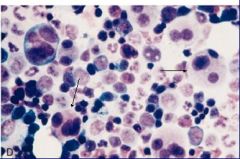
What are these arrows pointing at?
What disease? |
|
|
Langerhans Cell Histiocytosis
-sheets of histiocytes within a lymph node -Histiocytes have oval/round nuclei with vesicular chromatic -some have linear nuclear grooves -cytoplasm is abundant and eosinophilic |
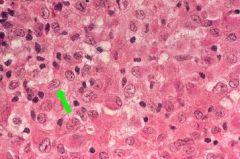
What disease?
|
|
|
Birbeck granules = "tennis racket"
Langerhans cell Histiocytosis |
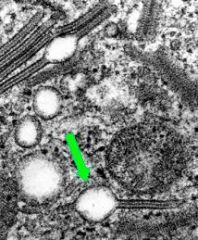
What is the arrow pointing at?
What disease is this pathognomic for? |
|
|
B. CML
|
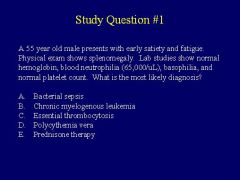
-
|
|
|
C. Lymphocytosis
|
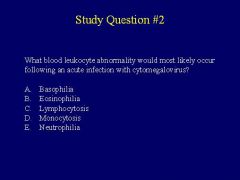
-
|
|
|
A child presents with exophthalmos, diabetes insipidus, and cystic defects in the skull
|
Hand-Schuller-Christian Disease
|

